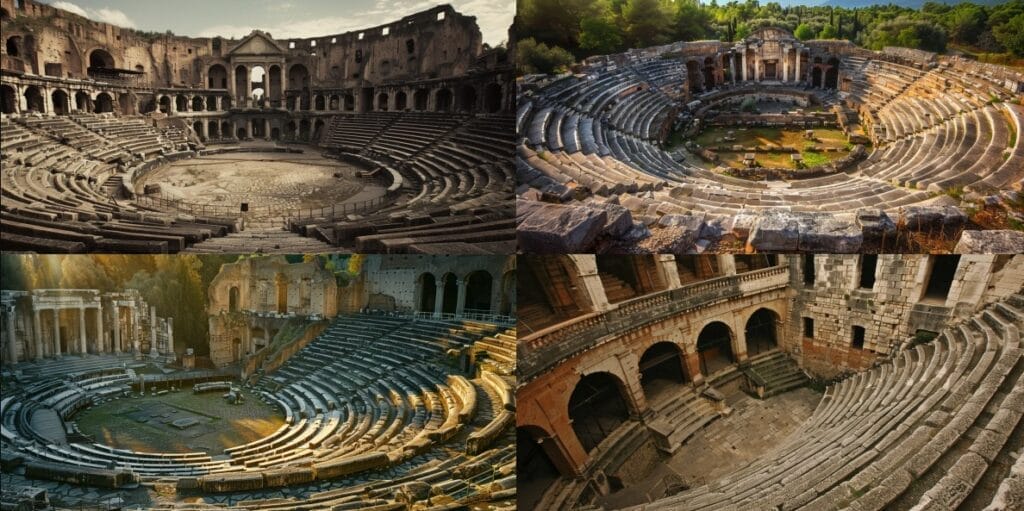
Roman theaters were not just venues for entertainment; they played a pivotal role in the cultural and social dynamics of ancient society.
The Roman Empire witnessed the evolution of these structures from simple temporary wooden stages to grand stone edifices that reflected the grandeur of Roman architectural innovation.
These theaters were central to the communal life, where citizens gathered not only to watch performances but also to engage in civic and political events.
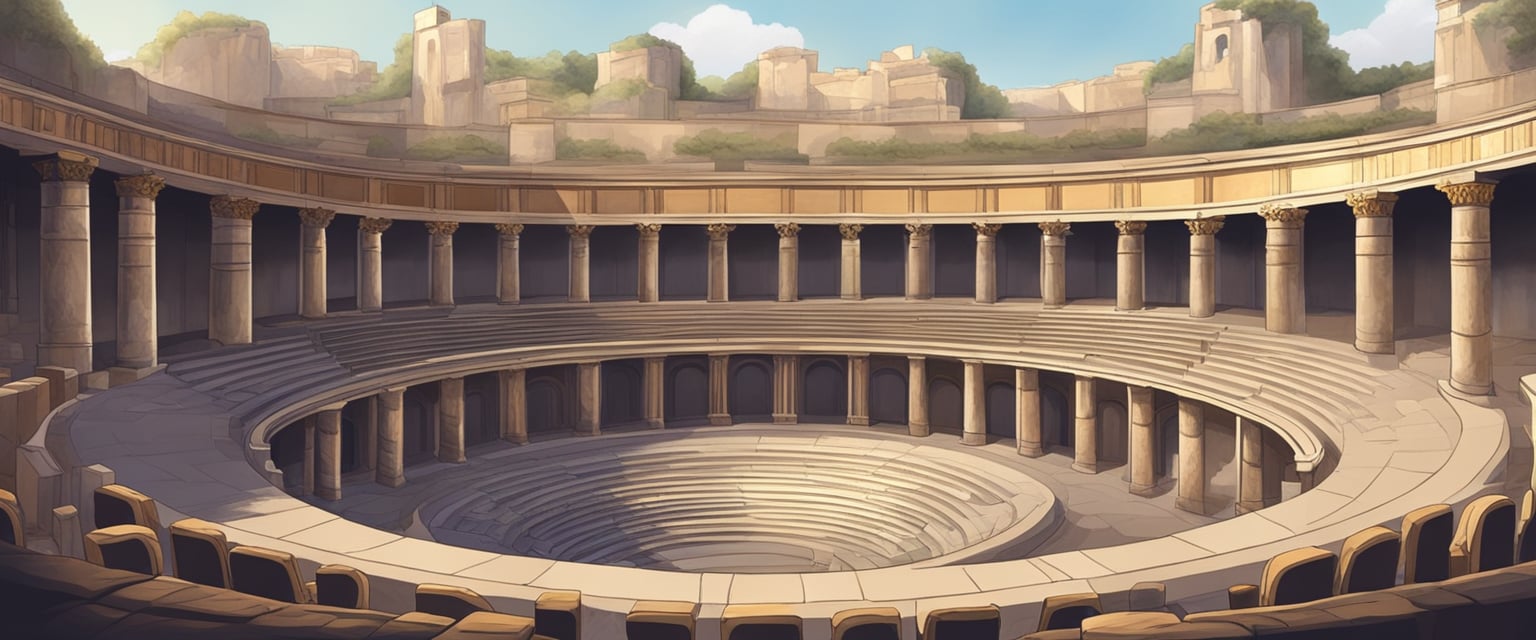
The architecture and design of Roman theaters were heavily influenced by Greek theater, but they also incorporated unique features that catered to the Roman taste and urban landscapes.
As these performances were an integral part of Roman culture, the theaters were built in a manner that allowed for a wide variety of shows, ranging from plays to gladiatorial contests.
The structural designs—including the scaenae frons, the orchestra, and the auditorium—optimized the spectator’s experience of the performance.
Key Takeaways
- Roman theaters were multifunctional spaces deeply integrated into ancient Roman culture.
- Architectural elements of these theaters were designed to enhance the experience of diverse spectacles.
- These structures symbolized Roman architectural prowess and societal values.
Origins and Evolution of Roman Theater
Roman theater emerged from the fertile cultural exchange with the Greeks and evolved as an integral part of public festivals and drama, reflecting Rome’s societal values and artistic progression.
Influence of Greek Theater
The Romans were deeply influenced by the art and culture of the Greeks, and this extended into the realm of theater.
They adopted the architectural style and dramatic genres of the Greek theater, adjusting them to fit their own cultural context.
Early Roman theaters were temporary wooden structures, modeled after Greek counterparts, but later became monumental stone edifices that symbolized Rome’s power and cultural aspirations.
Ludi and Public Festivals
Public festivals known as ludi played a pivotal role in the development of Roman theater.
These events, often sponsored by the state or wealthy individuals, celebrated religious and social occasions with lavish entertainment.
The introduction of theater performances into the ludi added a new dimension, combining athletics, chariot races, and dramatic presentations as a means of public spectacle and communal engagement.
Introduction of Drama to Rome
Drama was formally introduced to Ancient Rome by Livius Andronicus, a Greek captive who translated and adapted Greek works into Latin, merging Hellenistic traditions with native Roman elements.
This marked a key turning point as Rome began to develop its own distinctive theatrical traditions, while dramatic performances in Latin aided in the spread and reinforcement of the Roman language and culture.
Architecture and Structure
The Roman theater was a marvel of engineering, showcasing the Romans’ mastery of both architecture and structure. Theaters were a prominent feature in Roman cities, reflecting the value placed on public spectacle and cultural gatherings.
Design of Roman Theaters
Roman theaters typically featured a semi-circular design, with the cavea — the seating area — strategically tiered to provide optimal views for spectators.
The scaenae frons, or stage front, was an elaborate, multi-story façade that served as the backdrop to the performance space, known as the orchestra.
Roman theaters were designed to reflect their cultural importance and facilitate the massive audiences they attracted. In cities like Pompeii, the remains of these theaters serve as a testament to their enduring design principles.
Types of Structures
There were mainly two types of structures related to Roman theaters: permanent stone theaters and temporary wooden structures.
The stone theaters were monumental, lasting edifices, prominently featuring in urban landscapes. In contrast, temporary wooden structures were erected to host fleeting events and could be taken down as needed.
These temporary structures often preceded the more durable stone theaters, which were eventually constructed throughout the Roman Empire.
Acoustic Innovations
Roman architects were pioneers in the field of acoustics, implementing designs that enhanced the audience’s auditory experience.
The layout of the cavea and the materials used in construction worked in unison to channel sound effectively from the stage to the furthest seats.
Innovations such as the amphitheater took these principles further, encapsulating the crowd within a fully enclosed oval form that amplified the spectacle’s sights and sounds.
Cultural and Social Aspects
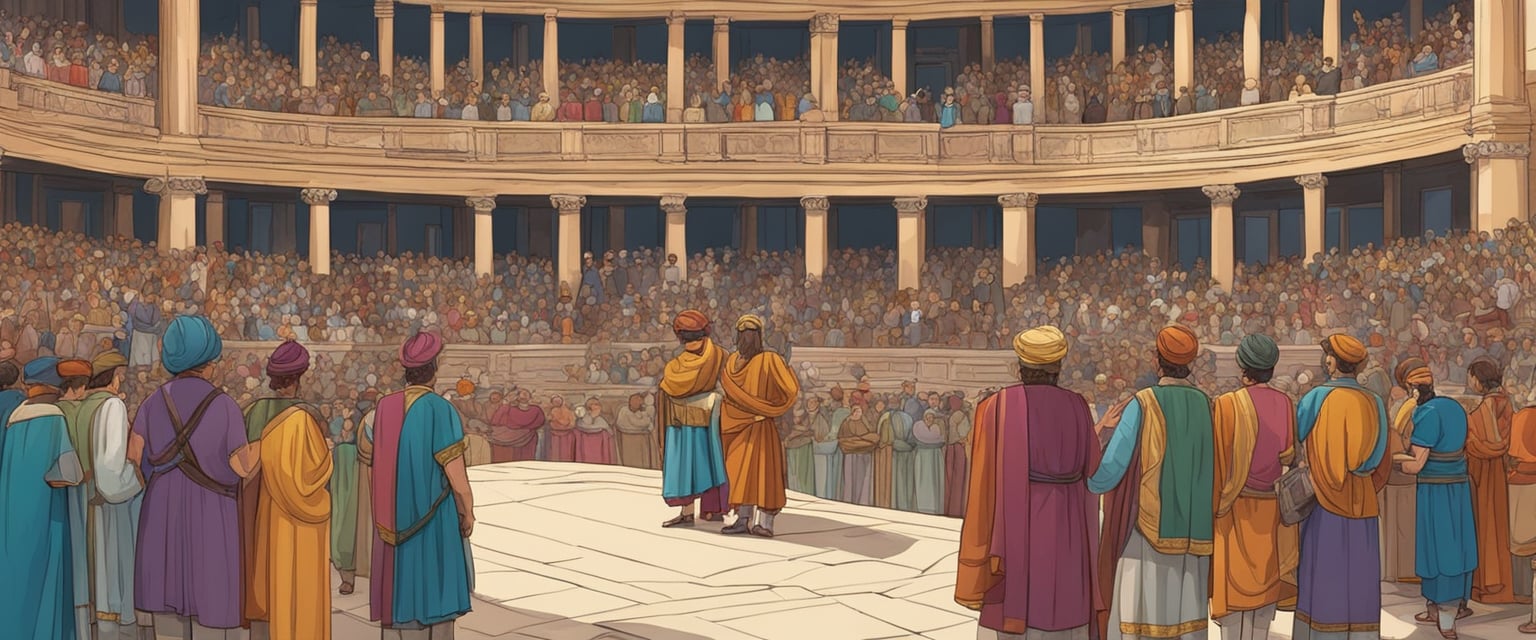
In the Roman Empire, theaters were more than just venues for entertainment; they were integral to the cultural and social framework, reflecting and reinforcing the societal norms and hierarchies of the time.
Role of Theater in Roman Society
Theaters in ancient Rome were significant spaces for social interaction and cultural exchange.
They served as important venues for a variety of performances, such as plays, orations, and musical events, which were aesthetically pleasing and also a means of imparting Roman values and ideologies.
For citizens, attending the theater was a common practice and an essential aspect of public life.
Social Stratification and Seating Arrangements
Seating arrangements in Roman theaters mirrored the social class structure.
Magistrates and elite members of society occupied the prominent lower seats, known as the ima cavea. Ordinary citizens had seats further back, while women and the lower classes were relegated to the upper tiers or summa cavea.
This spatial organization visibly showcased the social hierarchy and reinforced the divisions within the society.
Theater as a Means of Control
Roman authorities often used theater as a tool for maintaining social control and political stability.
By offering free admission to theater spectacles, magistrates could appease and entertain the populace, distracting them from political issues.
Spectacles in the theater provided a platform for emperors and politicians to demonstrate power and propagate state-approved messages, thus using entertainment to subtly exert influence over spectators.
Literary and Artistic Contributions
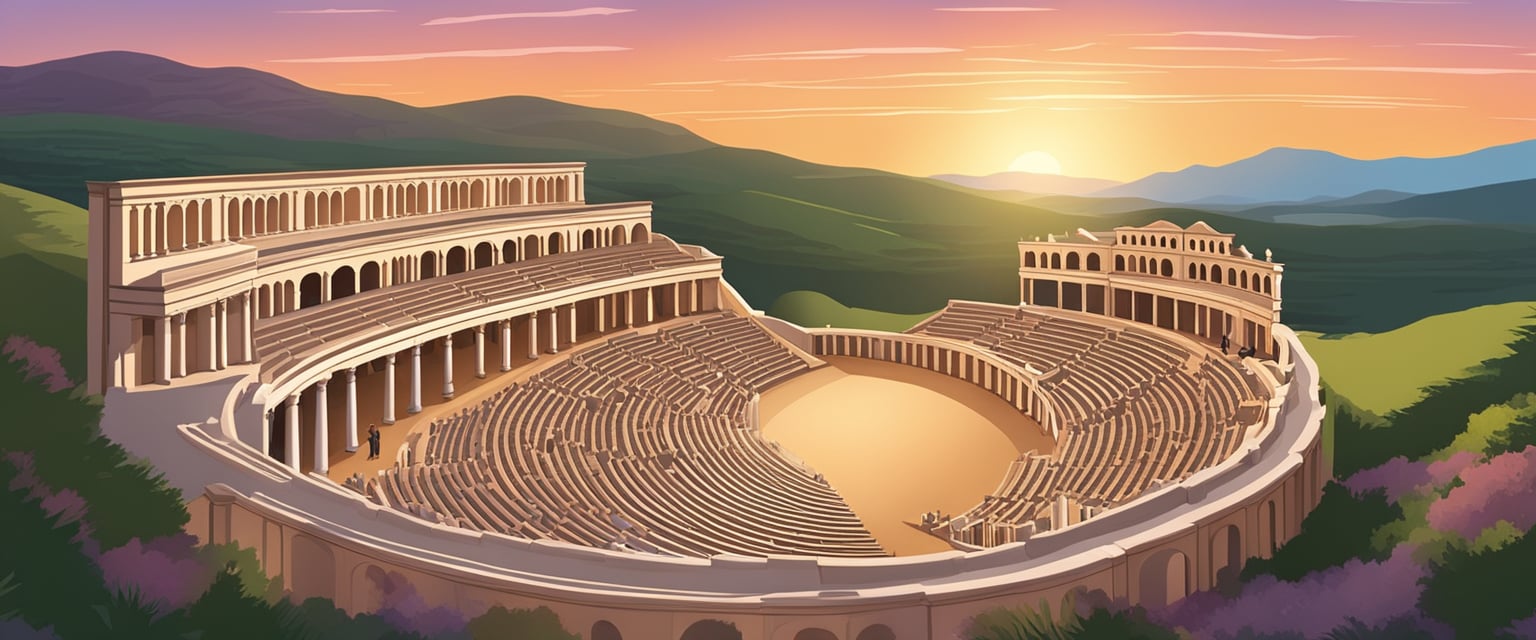
The literary and artistic fabric of Roman theater was rich and multifaceted, with contributions spanning from inventive playwrights and their compelling works to the evolution of distinctive theatrical genres that resonated with Roman societal values and tastes.
Notable Playwrights and Works
Roman theater flourished with the works of prolific playwrights like Plautus and Terence, who significantly shaped the landscape of Roman drama.
Plautus’s career produced a plethora of plays, of which about 20 survive, including the renowned Palliata such as Miles Gloriosus and Menachmi.
Terence, another key figure, crafted six influential works, like Andria and Adelphoe, which displayed more refined language and complex characters.
These literary works, rooted in comedy, often explored common life and social norms of the day, setting the blueprint for the genre of Roman comedy.
Development of Roman Genres
Roman theater genres underwent a fascinating evolution, with tragedy and comedy being the primary categories.
Tragedy in ancient Rome often stemmed from Greek influences, giving rise to Latin tragedy, although few works survive to provide a comprehensive understanding of its nature.
On the other hand, Roman comedy thrived, divided into two sub-genres: the palliata, dealing with scenes in a Greek setting, and the togata, based on Roman subjects.
Beyond these, Roman theater embraced pantomime and mime, delivering more performance-driven, less scripted entertainment that captivated audiences with expressive narratives without reliance on intricate literary language.
These genres reflected an adaptability and creativity that underscored the varied social functions of Roman theater as a mirror to society, a platform for satire, and an arena for spectacle.
Performance and Production Elements
In Roman theaters, the spectacle of drama and entertainment was brought to life through skilled actors, elaborate stagecraft, and distinctive costumes and masks. Each element played a critical role in contributing to the grandiosity of performances.
Actors and their Roles
The actors in Roman theater were predominantly male and took on various roles, including that of mimes, which were performed without masks.
They employed an exaggerated style of acting suitable for the large theaters to ensure visibility to all spectators.
Notably, vocal projection and clear articulation were vital, as the audience spanned considerable distances from the stage.
Stagecraft and Scenography
The stage in a Roman theater, known as the ‘scaenae frons’, was an elaborate structure featuring a decorated background. It often included multiple levels and intricate columns and arches.
Scenography, the art of creating theatrical scenes, involved:
- Using movable painted panels: To change scenes.
- Machinery: For special effects like flying or dramatic entrances.
- Theatrical equipment was also utilized for creating sound effects to accompany actions on stage.
Costumes and Masks
Costumes and masks were integral to defining characters and conveying their roles:
- Costumes: Embellished and colorful, distinguishing characters by social status, gender, and occupation.
- Masks: Crafted to depict a variety of personas, these were essential for visual exaggeration and acoustic purposes, as they helped amplify the actor’s voice.
Roman theater costumes and masks also helped a small number of actors to portray multiple characters efficiently.
Roman Theater in the Wider Empire
The Roman Empire’s theaters extended far beyond Rome, showcasing the cultural and architectural influence of Roman society. These theaters were not mere venues for entertainment; they were symbols of Roman architectural ingenuity and a means to disseminate Roman culture throughout the empire.
Spread of Roman Theaters
Through the process of Romanization, theaters began to appear extensively across the provinces.
Spain and France, for example, still have remnants of Ancient Roman theaters, which serve as a testament to the widescale establishment of cultural sites in conquered territories.
The Great Roman Theater at Apamea, Syria, possibly one of the largest in the empire, is illustrative of the importance the Romans placed on such structures as part of urban development.
This clear geographic dispersion highlighted Rome’s commitment to integrating its culture within the day-to-day lives of its provincial citizens.
Regional Variations in Design
Despite a common architectural thread, regional theaters often integrated local styles and materials, leading to diverse structural forms.
For instance, the Roman theater in Pula is notable for its preservation and adaptations unique to the region.
The Architecture of Roman theaters varied widely.
For example, some theaters may have been open-air while others were covered.
Details such as stage design, seating arrangements, and acoustics were adapted to local conditions and resources, demonstrating the Romans’ skill in engineering and construction.
Preservation and Legacy
Preservation of Roman theaters and their ongoing legacy play a crucial role in maintaining the link between ancient civilization and modern culture. These structures offer a tangible connection to the theatrical practices and social customs of ancient Rome.
Modern-Day Ruins
The Colosseum, perhaps the most iconic of all Roman amphitheaters, stands as a testament to Roman architectural ingenuity and the enduring appeal of Roman public entertainments.
Partially ruined due to earthquakes and stone-robbers, it continues to dominate the landscape of the Roman Forum, eliciting awe and providing educational insights into ancient Rome’s cultural psyche.
Efforts have been made to stabilize and restore the structure, ensuring that this monument endures as a central figure in Rome’s legacy.
Pompeii’s preserved theatric structures provide another glimpse into the Roman world.
The Wall paintings preserved at Pompeii offer invaluable details on decor and aesthetics of the era.
Reinforcement and preservation efforts are vital to protect these historical treasures against the elements and the passage of time.
Influence on Contemporary Theater
The Roman approach to theater design has significantly influenced today’s performance spaces.
Aspects such as tiered seating and the semi-circular orchestra pit hail directly from ancient Roman prototypes.
For instance, the architectural framework of the Theatre of Pompey — a venue that once stood as Rome’s premier stage — echoes in modern stadiums and theaters across the globe.
Roman theaters, through their architectural innovations, have provided a blueprint for current theatric and public gathering venues.
These ancient sites have influenced contemporary theater-makers, allowing them to adapt and meld historical elements with modern creative sensibilities, preserving the legacy of Roman entertainment.
Conclusion
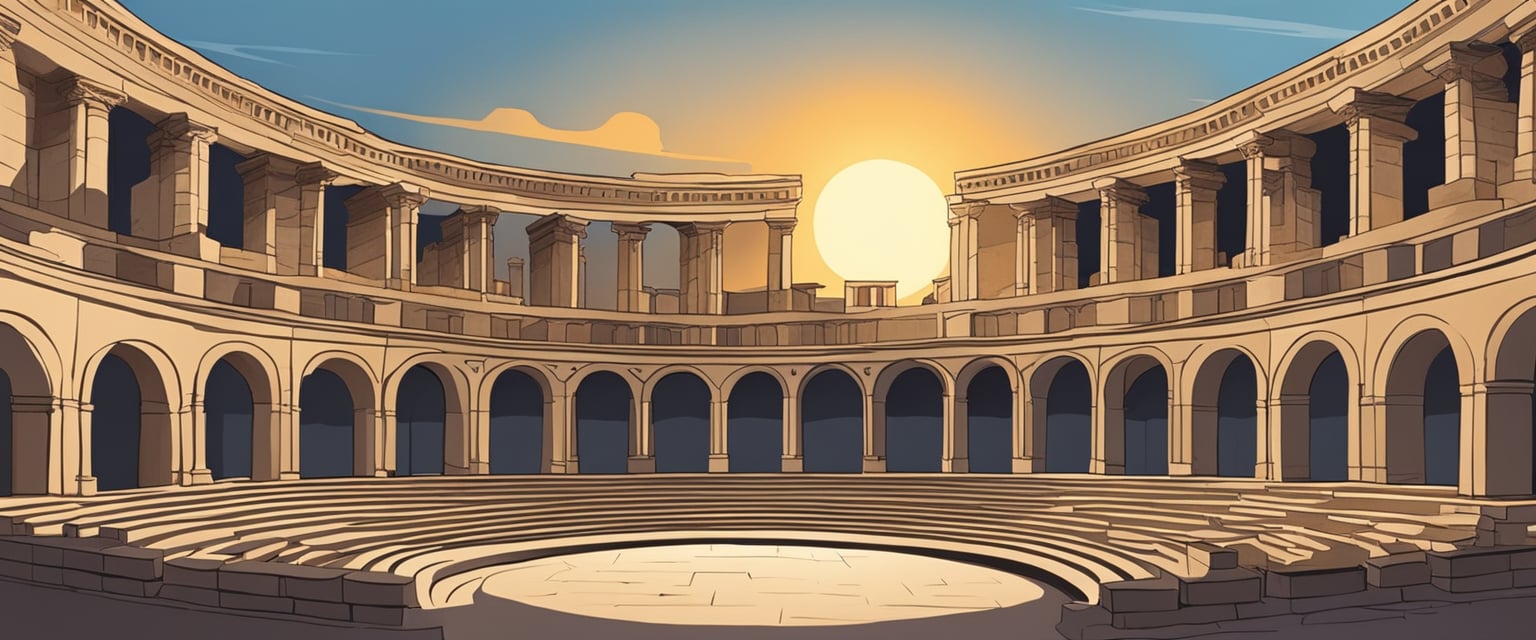
Roman theaters were an integral part of social and cultural life in ancient Rome. They served not only as venues for entertainment but also as spaces for community gathering and the expression of Roman societal values.
The remains of these structures offer insights into the architectural expertise of Roman builders and their understanding of acoustics and audience engagement.
Theaters typically featured a semi-circular design, indicating an emphasis on visibility and acoustics, allowing spectators to enjoy performances without the aid of modern technology.
In the archaeological study of Roman theaters, research suggests that state-sponsored ludi scaenici were significant cultural events. These insights are drawn from combining social practices with the material record.
The construction and design of Roman theaters evolved over time, with influences and improvements made by various emperors.
The intricate scaenaefrons (stage front) is a testament to the artistic grandiosity of the period, with some attributing developments in design to the Hadrianic or early Antonine period.
Scholars continue to analyze historical texts and excavations to further understand the existence and development of theaters in the post-Roman world.
For instance, the Description of a show provides evidence of theatrical activities during the twelfth and thirteenth centuries, signifying the lasting impact of Roman theater.
The work of Vitruvius and his writings on theater design also remain a crucial point of study.
This provides a critical link to comprehending how Roman architects may have laid out their theaters, showcasing a blend of practicality and aesthetic sensibility.
Ultimately, Roman theaters reflected the empire’s grandeur and its enduring influence on subsequent generations, not just in architecture, but in societal norms and cultural practices.
Frequently Asked Questions
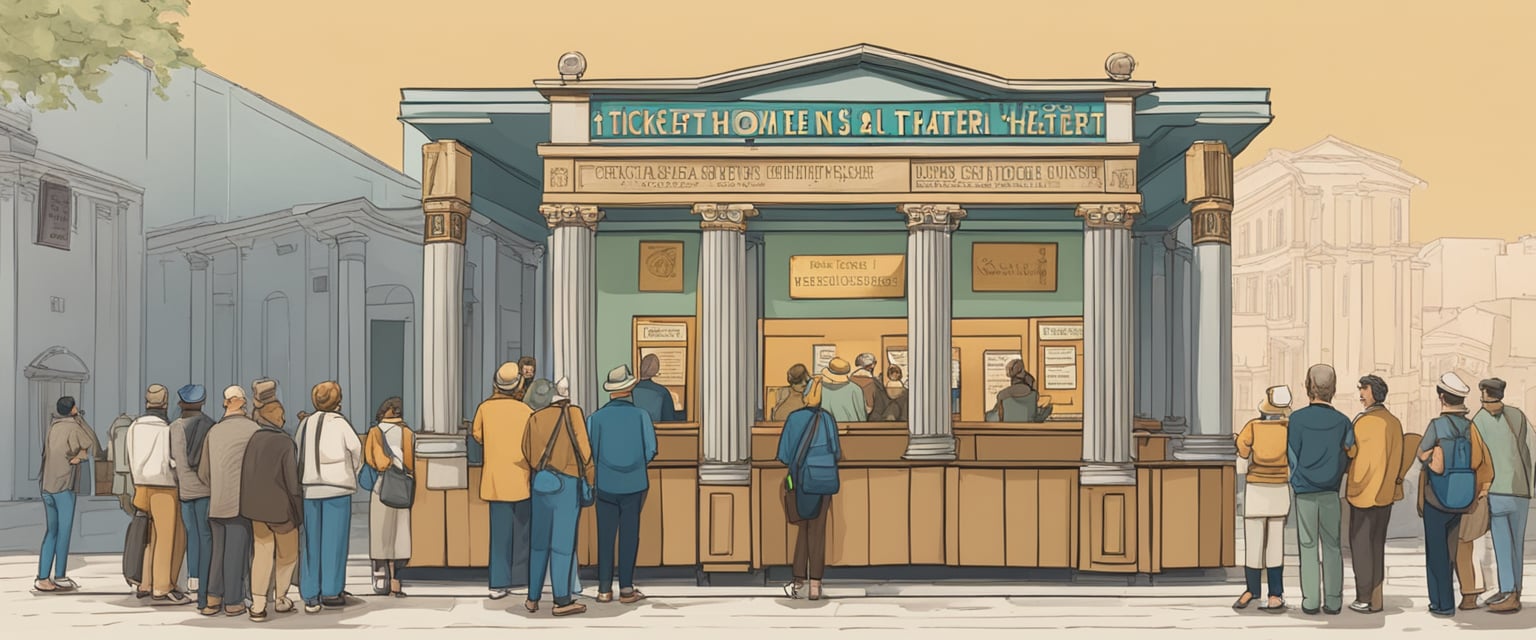
This section explores commonly asked questions about ancient Roman theater, covering topics from notable playwrights to the architectural features that distinguish Roman theaters.
Which playwrights were prominent in ancient Roman theater?
Prominent playwrights of ancient Roman theater include Plautus, Terence, and Seneca. Their works were fundamental in shaping Roman theatrical tradition, blending elements of Greek theater with local cultural influences.
What are some examples of Roman tragedy plays?
Examples of Roman tragedy plays are Seneca’s “Phaedra” and “Oedipus”. Although few Roman tragedies survive, these works are testament to the Roman contribution to the genre, characterized by strong emotions and complex characters.
How did actors in ancient Rome contribute to the theatrical experience?
Actors in ancient Rome were highly skilled performers who utilized gestures, vocal techniques, and distinctive masks to convey their characters.
They were often slaves or freedmen, and their performances were central to the theatrical experience, captivating audiences with dramatic storytelling.
Can you list some of the most famous Roman theaters that have survived?
Some of the most famous Roman theaters that have survived include the Theater of Pompey in Rome, the Roman theater at Corinth, and the Theater of Orange in France. These sites continue to be of great historical and archaeological significance.
What are the distinctive characteristics of Roman theatre architecture?
Roman theater architecture is characterized by semi-circular structures, prominent use of arches, and scaenae frons, a permanent, elaborately decorated stage background. Unlike the Greeks, Romans often built their theaters on flat ground, relying on complex vaulting systems to support the cavea or seating areas.
What was the role and significance of masks in Roman theatre performances?
Masks in Roman theatre were essential for projecting a character’s personality and social status. They were designed to amplify the actor’s voice and expressions. These masks allowed a single actor to play multiple roles and were an integral part of the visual spectacle of Roman theatre.
